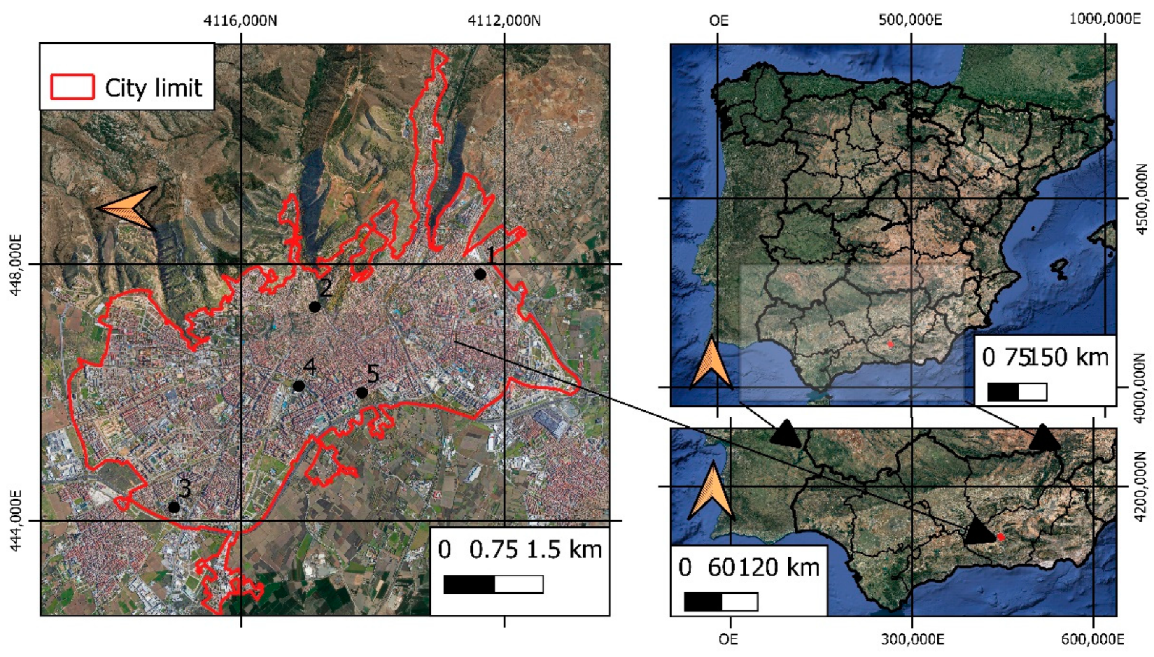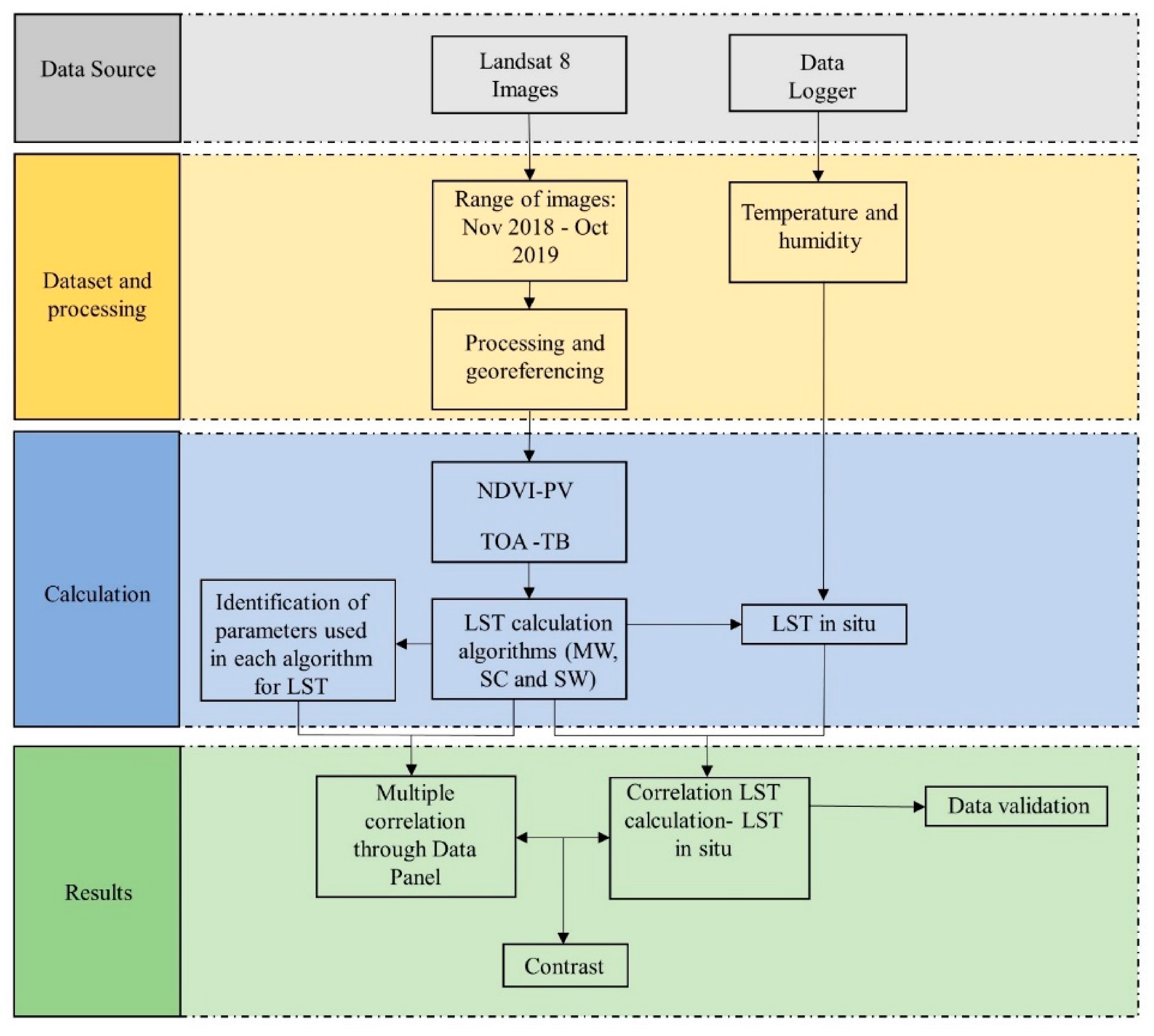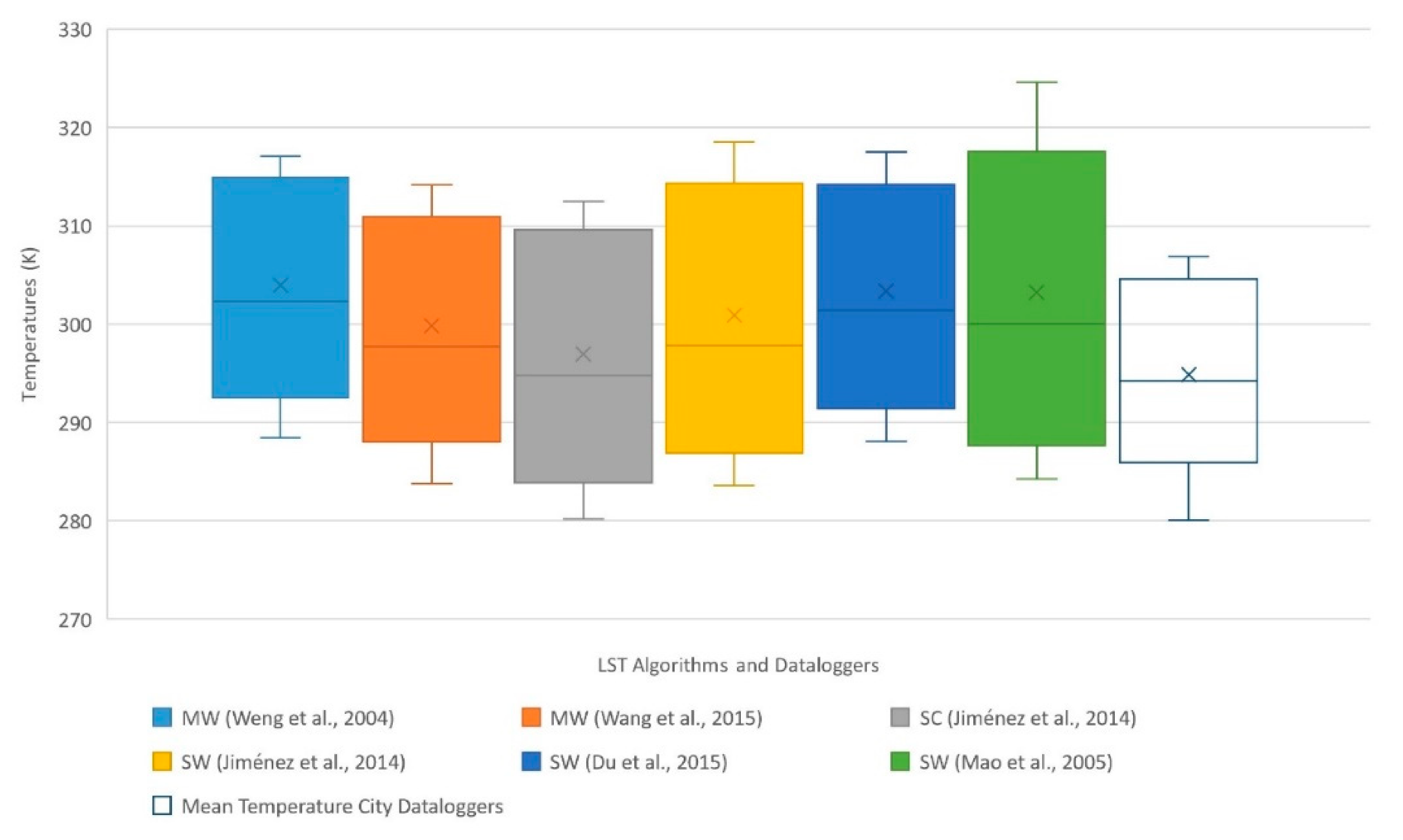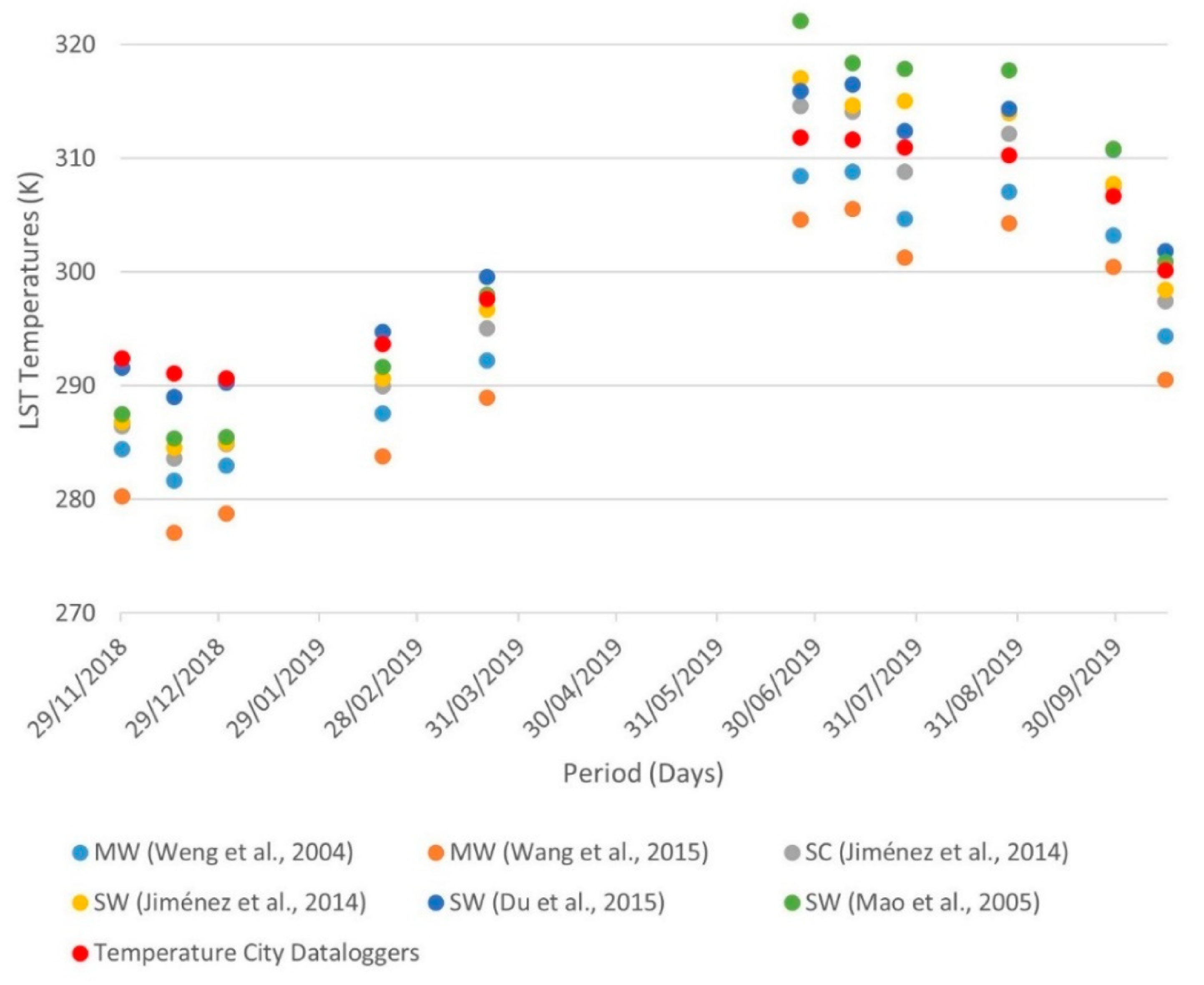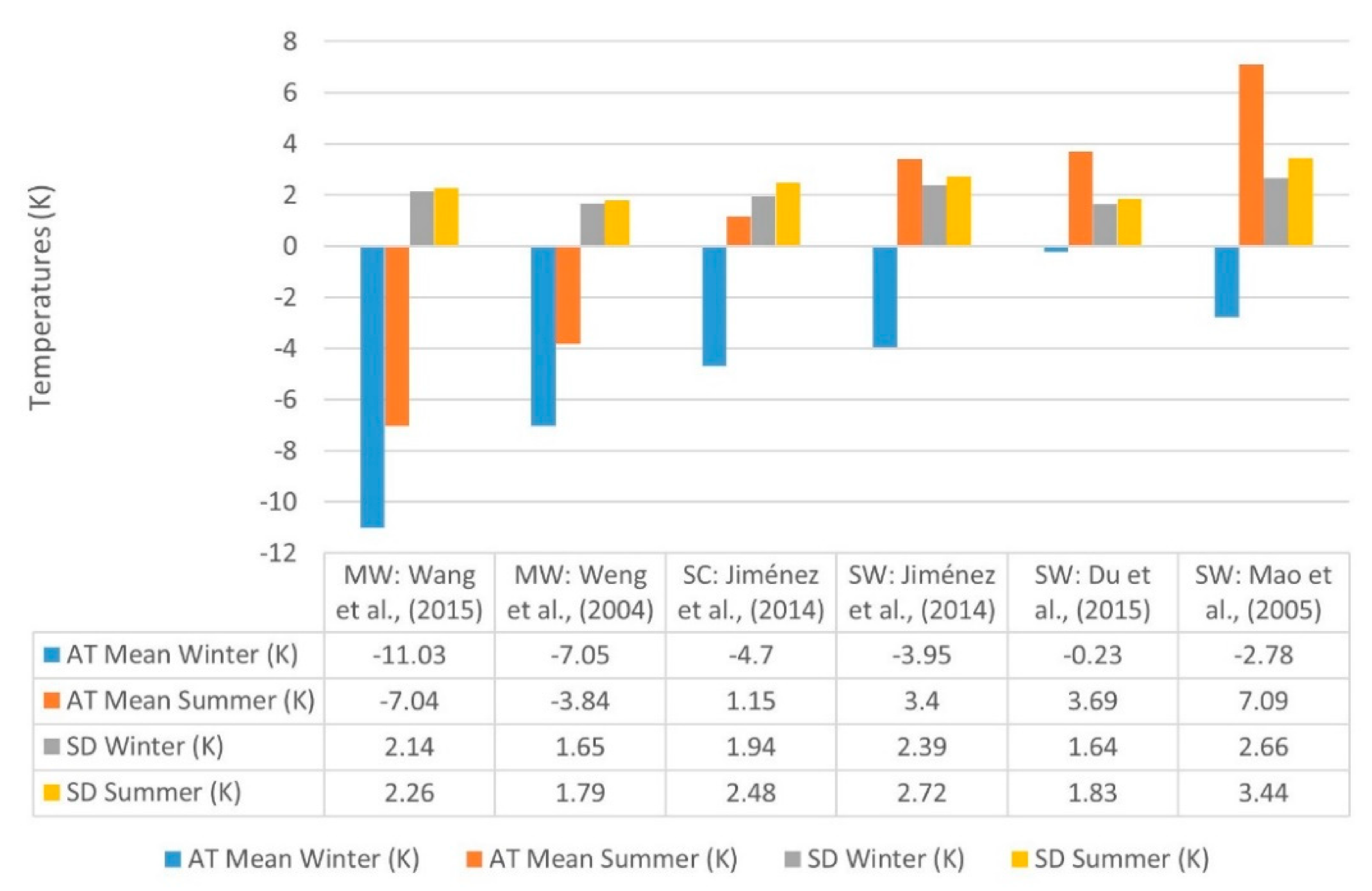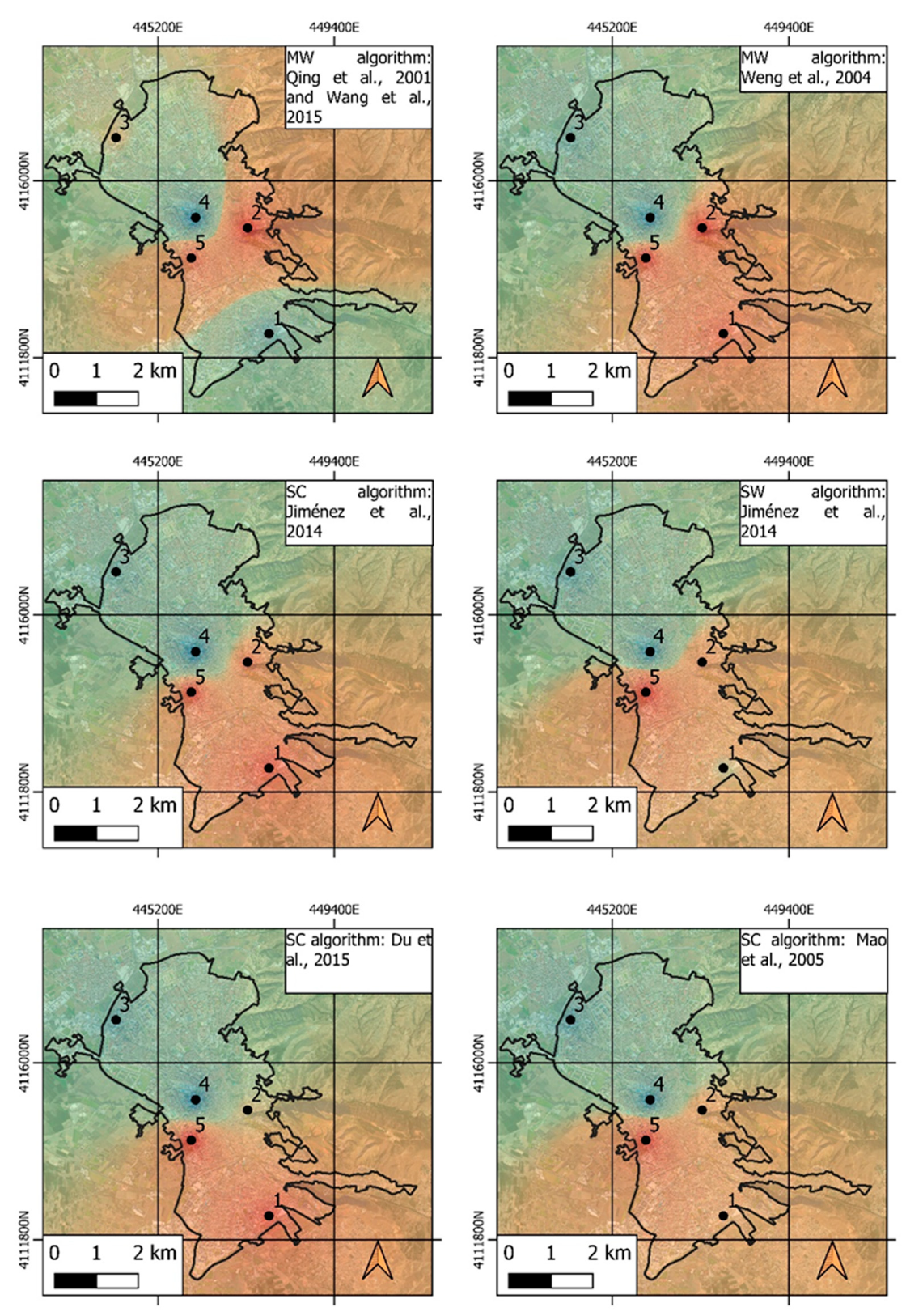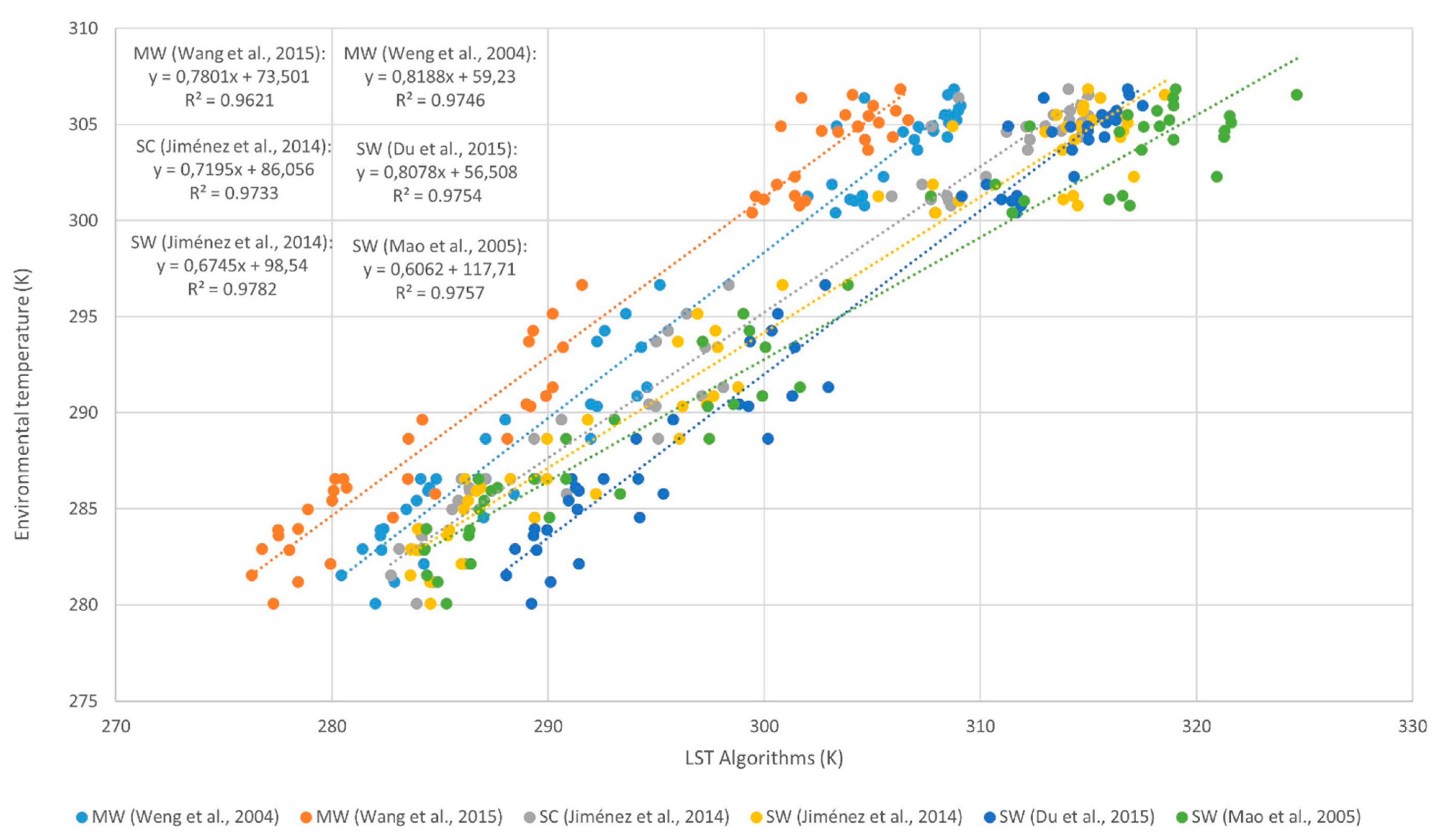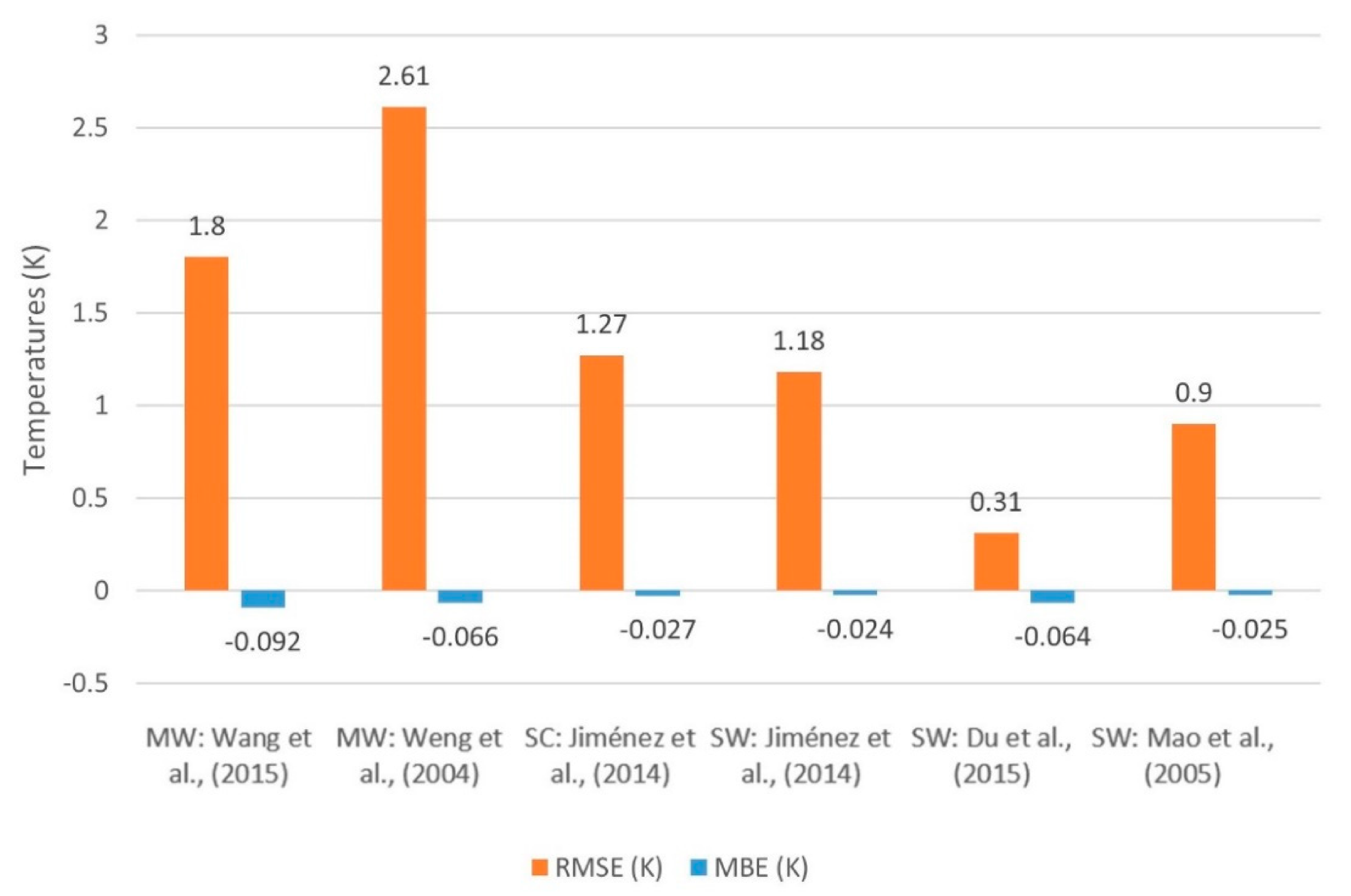1. Introduction
The land surface temperature (LST) is an essential factor when studying physical processes on earth [
1]. It is used for reference worldwide, in research dealing with local or regional space and in the fields of hydrology, meteorology, and superficial energy balance [
2,
3,
4], as well as studies surrounding climatic change [
5] and recent work involving the phenomenon known as urban heat island (UHI) [
6,
7,
8,
9,
10]. It can be of vital importance to obtain a reliable LST, and this value could bear an impact upon the quality of life of populations. It has therefore become an essential factor, used to evaluate the interchange of water and superficial energy with the atmosphere [
11].
Due to the important economic cost of measurements in situ and the difficulties involved in running them on vast extensions of territory, since the 1990s retrieval of remote sensing satellite images with sensors of thermal infrareds (TIRS) has become a more common approach. Training for the implementation of these systems is an important line of research [
12] evidenced by the ample literature on the subject [
12,
13,
14,
15,
16,
17,
18,
19,
20]. Still, the technological improvements incorporated by the infrared sensors of today’s satellites with respect to their predecessors urge researchers to keep on conducting research aimed at further advances in the field.
Numerous LST products have been developed based on satellite data. One of them, the Landsat, was the eighth satellite put into orbit in the year 2013. It features thermal infrared sensing (TIRS) bands 10 and 11, providing LST estimates of 16 days, and a 100-m resolution. When put into operation, the bands gave radiometric errors that surpassed the maximum value permitted (2%)—absolute values of 4%–5% were obtained for the measurements of band 10, and 8%–9% for band 11 [
13]. To correct these deficiencies, authors Gerace and Montanaro (2017) [
21] proposed an optical flare correction algorithm named the Stray Light Correction Algorithm (SLCA). It came into use in February 2017 for the images of the Terrestrial System of the US Geological Service (USGS) and is used for training in the field through a process of intervening validation [
9,
10,
13,
14,
15].
Since the onset of its use, Landsat 8 has proved useful for determining the LST in large cities as well as prosperous, growing mid-size cities such as Lyon (France) [
22], Krakow (Poland) [
23] and Vienna (Austria) [
24]. A variety of validated algorithms may be adopted to recover the LST through Landsat 8 satellite images [
16,
17,
18,
19,
20,
25,
26]. They are based on the principles of fluid dynamics and atmospheric physics [
27] and comprise three major groups: the mono window (MW) developed by Weng et al. (2004) and Qing et al. (2001) [
17] and later improved by Wang et al. (2015) [
28]; single channel (SC), developed by Jiménez and Sobrino et al. (2014) [
16]; and, finally, the split window (SW) algorithms developed by Jimenez and Sobrino et al. (2014) [
16], Du et al. (2015) [
20] and Mao et al. (2005) [
18]. The two first groups used a single TIRS channel for calculation, typically band 10; the latter group relied on two, bands 10 and 11. MW algorithms are based on individual atmospheric parameters: ambient temperature, humidity, and atmospheric mean temperature [
12]. In turn, the SC algorithm [
16] accounts for ground emissivity (ε) and steam-driven content of water (w) in the atmosphere (Yu et al. 2014). The great advantage of SW algorithms is that they do not require atmospheric data of great precision [
29]. Thus, authors Jiménez et al. (2014) [
16] established that they work well in global conditions and provide better results than SC algorithms. Xiangchen et al. (2019) [
14] hold that SW algorithms are best suited for Landsat 8 estimates, though further investigation is necessary to validate the precision of these algorithms.
Currently, the use of algorithms to retrieve the LST presents two major challenges. 1. The spatial resolution of the pixels of LST systems can vary from 10
−2 to 10 Km
2 depending on the satellite used. This circumstance can give rise to pixels that represent various types of surfaces, which makes it difficult to obtain the LST [
30]. 2. The satellite LST requires a verification process to validate the performance of the algorithms used. Common LST algorithm validation techniques are: in situ measurements, the radiance method, or cross reference and comparison with ambient temperatures near the ground. The first method is difficult and expensive, requiring radiometers located on terrains of homogeneous coverage (lakes, grasslands, dunes and regions with vegetation) and a dimension equal to the pixel of the satellite image. This method can give differences of 2 to 5 Kelvin degrees (K) with respect to actual measurements, according to previous studies [
31]. For this reason, only a few validation studies using this method are found in the literature [
32,
33,
34,
35]. The main drawback of the second method is that it calls for knowing the emissivity of the soil and atmospheric profiles in situ. These can be simulated using MODTRAN 4.0 software, whose use is common in the literature [
13,
36,
37] but requires verification that the simulated profiles are adapted to the actual atmosphere of the point studied [
38]. The third method involves the validation of LST values retrieved against alternative LST values, either well documented or validated by other satellites [
19,
39]. It has the advantage of not requiring in situ or simulated measurements, but the precision is very sensitive to spatial and temporal mismatches of the measurements [
30], and similar spatial resolutions are needed to proceed with the validation. In recent decades, the method of comparison with ambient temperatures near the ground (1–2 m) has gained importance as a validation system for LST algorithms [
40,
41,
42,
43,
44]. It consists of comparing the recovered LST with the ambient temperature obtained from meteorological stations or temperature probes located near the ground. It is a fast, simple and low-cost method, but its main drawback lies in finding pure pixels of vegetation within cities that do not comprise several surfaces [
30,
37]. This inconvenience is minimized by using Landsat 8, since the resolution of its thermal bands is 100 m—an adequate distance to locate green or bare areas within or adjacent to cities. The precision of this method has reported differences ranging from 0.2 to 7.8 K between the recovered LST and the measured ambient temperatures [
40,
41,
42,
43,
44,
45].
The city under study presents important problems related to the local climate, conditioned by its proximity to the Sierra Nevada mountain range (30 km away), with average heights of 2045 m above sea level, and to the Mediterranean coast (60 km away). Granada is located in a former basin of the Mediterranean Sea and is considered highly vulnerable to climate change, given its high rate of increasing temperature as compared to the rest of the planet [
46,
47]. In addition to these geographic and climatological elements, Granada faces environmental challenges, having become the third most polluted city in Spain [
48]. To the best of our knowledge, ours is the first study dedicated to LST estimates using satellite images of this area, and one of the first conducted on a Spanish city, after research on Barcelona [
49,
50] and Madrid [
51].
Numerous studies have come to positively link environmental pollution with an increase in LST in urban areas [
30,
52,
53,
54]. Paradoxically, although many LST studies involving Landsat 8 images have been validated by the method of comparison with ambient temperatures [
40,
41,
42,
43,
44,
45], the possible effect of contamination on the environment has not been assessed in terms of the precision and subsequent validation of the LST. In sum, the geographic, climatic and high pollution conditions of the city of Granada make it an ideal place for this research.
The main statistical approaches and methods commonly used in studies of LST recovered through Landsat 8 images are: descriptive statistics of linear correlations and regressions [
35,
55,
56,
57], multiple regression analysis (MRA) [
58,
59], bivariate correlation [
60] and ANOVA [
61,
62,
63]. The panel data method used in this research allows for the incorporation of a greater number of data and variables, admitting the inclusion of individual effects of a certain variable to derive global results. It also allows inclusion of the spatial residual values of the results and eliminates the usual problem of collinearity between variables. Such considerations are often neglected by traditional methods, impeding the arrival at more accurate and complete results.
Therefore, the questions that we aim to answer through this research, in view of the particular characteristics of the city of Granada, are the following: (1) How does one choose the right LST algorithm for Landsat 8? (2) Is the validation method of comparison with ambient temperatures adequate? (3) Does panel data statistical analysis lead to different data than traditional analysis methods?
The foremost objective of this research is to determine the precision and maturity of six LST algorithms on Landsat 8 images validated using the technique of comparing ambient temperatures over the city of Granada (Spain), with its unique geographic, environmental and pollution characteristics. Specific goals include: 1. Determining if high contamination can affect the validation process of the chosen LST. 2. Providing a new low-cost, fast and accurate approach that allows the variations of the LST of cities to be monitored in an urgent and precise way, taking into account physical, environmental and climatic variables. In the long term, such efforts may contribute to decision-making by urban planners and public administrations about the distribution of the LST inside cities.
4. Discussion
In this research, mean LST differences obtained by algorithms were lower than the ambient temperatures measured near the ground. However, the LST differences derived using algorithms were uneven, SW methods giving values above the mean, while MW values were well below the mean. The SC method gave a value around the mean. Therefore, the values obtained from the SW and SC algorithms largely agreed with data reported previously [
40,
41,
43,
44,
45] in studies of other cities or territories using the comparison of temperatures near the ground as a validation method. These studies gave LST results superior to those obtained by environmental temperatures ranging between 0.7 and 1.0 K in the city of Hong Kong [
40], 3 and 7 K in studies of cities in Senegal [
45], 0.2 and 7.8 K in studies of various cities in Canada [
41], the United Kingdom and the USA, where the authors [
43] reported differences between 2.58 and 7.62 K. On the contrary, the MW algorithms presented differences that were below ambient temperature. This circumstance was already reported by the authors of [
42] in their LST studies using MW algorithms in India, where they obtained differences between 3 and 4 K lower than ambient temperatures.
Evidence of the relationship between pollution in the city of Granada and the LST recovered by all algorithms was found. This relationship has been reported by numerous investigations [
12,
79,
85,
86], validating the results presented here. In light of the LST results cited above, and the relationship between LST and contamination, it cannot be said that contamination affects the LST recording using Landsat 8 algorithms.
We found that the temperature curves derived from algorithms MW and SC were similar in shape and intensity. Contrariwise, the curves resulting from SW algorithms differed, above all in the summer season when the air humidity (w) diminishes. A similar finding was reported by other authors, with the same distribution [
12,
13,
14,
28,
50,
72]. It can be attributed to the number of TIRS bands that each algorithm uses—algorithms MW and SC use the data of a single TIRS channel (band 10), while SW algorithms rely on two TIRS (bands 10 and 11) with wavelength intervals that oscillate between 10.6 and 11.19 µm, and 11.50 and 12.51 µm, respectively. The uncertainty that could be generated in band 11, implying possible error in the algorithm of correction, contributes to this situation (SLCA). Although band 11 was in working order in February 2017, numerous authors insisted on the need to conduct further studies on validation [
12,
13,
25,
87] to verify its correct functioning.
The panel data for the study of relations between the dependent variable and the independent variables of every algorithm indicated they all yielded values with a level of significance over 95%. This means that the variability of the data accounts for an important percentage of the algorithm. Still, algorithms MW and SC presented R2 values superior to those of the SW algorithms. The variability in the data of the MW and SC is therefore better explained by their algorithms. Because the data of a single TIRS channel were used for the algorithms MW and SC, the possible uncertainty of band 11 used for SW appears more likely.
In turn, the more marked differences seen in the LST curves of the SW algorithms with respect to the others over the whole period of study can be interpreted as an overestimation of LST with low values of relative humidity (w), and an underestimation of LST with high humidity. Such a situation was described by García et al. (2018) [
13], who justified the bias of LTS for bands 10 and 11. This could also explain the standard deviations of the LST averages from season to season: larger values correspond to periods of low humidity (summer), and lower values to periods of high humidity (winter) [
12].
The data obtained in the city of Granada reveal an important distinction in LST between industrial and urban zones and suburban and green zones, along with the influence of the seasonal period. The maximum value detected between the two zones was 12.8 K, very similar to figures obtained by other authors [
7,
12,
35,
50,
88]. Lower values have been found in conjunction with zones having abundant green groundcover [
17]. The heterogeneous system of the city studied here allows for the distinction of industrial and urban areas with high LST and high density, plus vast surfaces of waterproof ground, as opposed to suburban areas with lower LST, low density, and limited waterproof surfaces. The lowest LSTs corresponded to surfaces with vegetation. The average LST differences between the urban and suburban areas of Granada increased by 50% in the summer period (as opposed to winter). Such findings are in line with the findings of other authors [
10,
15,
49]. The direct relationship between ground permeability and NDVI implies lower LST values in areas with high NDVI, and the other way around. Numerous studies corroborate this and validate the data obtained [
5,
7,
10,
12,
88,
89,
90]. The results obtained in the determination of the LST of the Spanish cities of Barcelona [
49,
50] and Madrid [
51] showed values that are very similar to those reported here. Thus, the hot zones identified in Barcelona and Madrid were the industrial ones and the urban fabric, in contrast to the colder zones located in the suburban zones and green zones [
49,
50,
51]. The mean differences detected between the two areas in both cities were between 1 and 2 K [
49,
50,
51], very similar to the values obtained in our investigation (1.34 K). The LST standard deviation values obtained in our research (winter = 2.39 K and summer = 2.72 K) are also very similar to those obtained by the authors [
49] for the city of Barcelona (winter = 2.3 K and summer = 3.1 K). The LST studies carried out on the city of Bangkok [
7] established that the highest LST was obtained in urban areas and not in industrial areas. This circumstance is motivated by the fact that Bangkok has an urban area of approximately 90%, reducing the industrial area to only 10%.
The R
2 determination coefficients obtained by means of the panel data technique for the compared algorithms were above 0.97, which denotes a good agreement of the values. The SC algorithm had the highest value, SW gave intermediate values, and MW the lowest values. The data obtained for the RMSE were between 0.31 K for the SW algorithm of authors Du et al. (2015) and 2.61 K of the MW algorithm of authors Weng et al. (2004). The SC algorithm of authors Jiménez et al. (2014) gave a value of 1.27 K, located in the central area of the interval. The higher the RMSE value, the worse the results presented by the proposed models. These values are in line with the findings of other authors [
11,
14,
15,
17,
37]. One study [
13] obtained values higher than ours, but this could be because the area under study was completely vegetal. With respect to the MBE data, higher values were reported for the MW algorithms of authors Wang et al. (2015) (−0.092 K) and the SW algorithm of Du et al. (2015) (−0.064 K). In turn, the lowest MBE values were obtained with the SW and SC algorithms of Jiménez et al. (2014) with values of −0.024 K and −0.027 K, respectively. The MBE is especially significant in determining the good agreement between the values of the algorithms, since it penalizes algorithms that present large errors with high values. One can verify how the MW algorithms present greater differences in temperatures and higher values of RMSE and MBE, with lower values in the coefficient of determination R
2. Contrariwise, the SC algorithm presents lower temperature differences and obtains lower values of MBE, intermediate values of RMSE and the highest value in the coefficient of determination R
2. These values denote a good agreement of data for the SC and SW algorithms, and low agreement in the data of the MW algorithms. Additional investigations [
11,
14,
15,
17,
37] have presented similar values, thus supporting the results obtained.
5. Conclusions
This is one of the first multi-temporal experiments aimed to determine LST with the Landsat 8 images of a Spanish city. Although such trials are common in large cities, in recent years they are becoming somewhat more frequent in mid-size cities. This circumstance, together with the morphologic and geographic characteristics of Granada, its levels of pollution and high thermal contrast, heighten interest in the results of our investigation.
According to our results, the LST of Granada can be determined using six algorithms under the categories MW, SC and SW, validated by intervening in situ, at five points, with datalogger measurements of temperature and humidity. Quantitatively close distributions and similar behaviors were observed for the city overall. However, important distinctions were seen between urban and suburban zones, and seasonal periods generated heterogeneous distributions. Even so, the results are largely in consonance with figures obtained at other geographic points.
In our study, SW algorithms gave higher LST values than MW and SC. We believe that these results can be applicable to other cities; indeed, they are similar to those obtained in investigations carried out elsewhere. The former uses the data from two thermal bands, the latter two using the data of a single band. The possibility of uncertainty in band 11 data can be corrected by the SLCA algorithm. The panel data method served to confirm that the variability in relations between the dependent variable and the independent variables of each algorithm is greater when a single channel (rather than two bands) is used.
The difference in means between the calculated LST and the LST in situ found here was lower for SC models (0.28 K), intermediate for SW (3.29 K) and highest for MW (−5.90 K). Coefficients of determination R2 of the LST obtained from algorithms and the LST in situ demonstrated high correlation, over 95%. Nevertheless, the SW algorithms presented larger coefficients than MW. Finally, RMSE and MBE values were inverse to the R2, being lower for SW algorithms and higher for MW. No evidence was found regarding the effect of high contamination on the process of obtaining the LST by means of recovery algorithms.
In our research, the SC algorithm gave the values closest to the ambient temperature obtained using dataloggers, and the values of RMSE, MBE and R2 were considered adequate. Therefore, it is deemed to be most suitable for evaluating the LST of the city of Granada, a medium-sized city with high levels of pollution and notable thermal differences, using Landsat 8 images. Even so, we consider it necessary to carry out more research to validate the precision of these algorithms and determine their possible impact on the contamination phenomenon.
The present contribution is significant in the context of LST determinations in mid-sized cities by means of Landsat 8 images. In view of the advantages and disadvantages encountered in this research regarding the selected algorithms, the inclusion of six algorithms could prove most useful for future LST studies of other urban areas. This novel, low-cost, fast and accurate approach allows one to monitor variations in the LST of cities in a precise manner, taking into account physical, environmental and climatic variables. Ongoing efforts are aimed to complement this study. Future studies involving the LST of other cities worldwide will underline the importance of validating the precision and maturity of algorithms used in multi-temporal assessments. Ultimately, this should contribute to well-founded decision-making by urban planners and public administrations in view of the distribution of the LST in cities.
